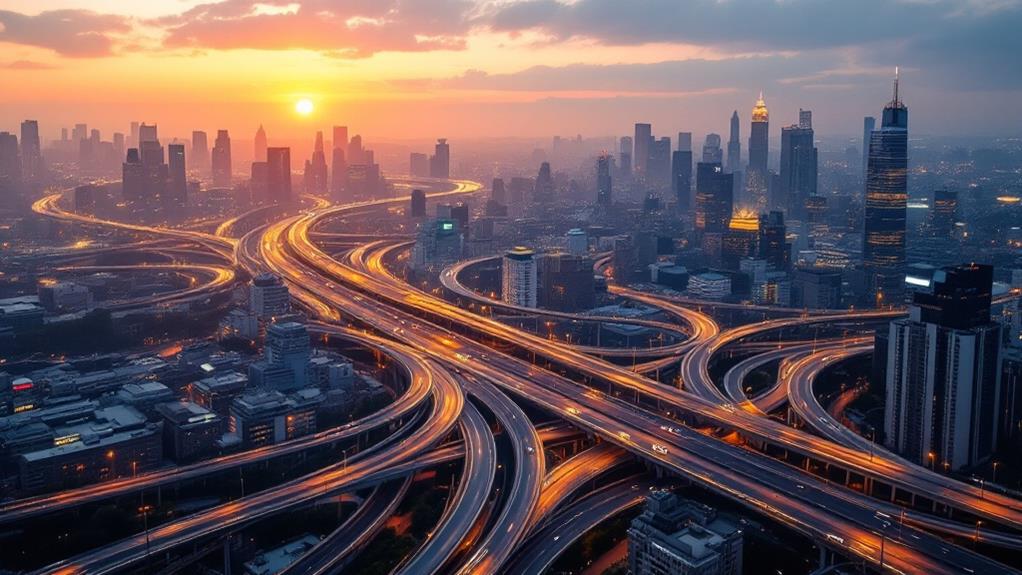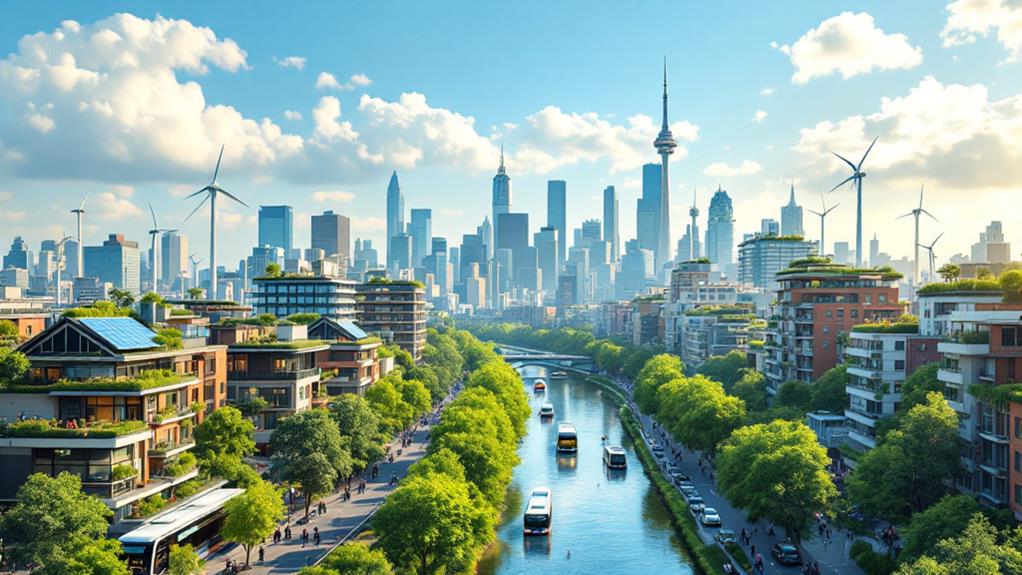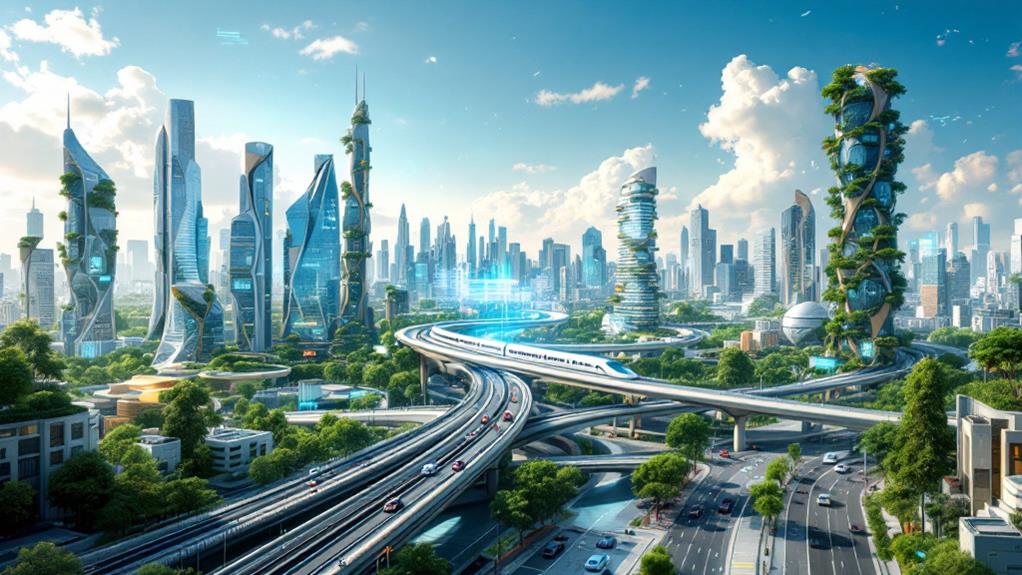How Infrastructure in the Largest Urban Areas Keeps Cities Running

You're surrounded by a complex network of infrastructure that silently powers urban life and keeps the largest cities thriving. Key elements include transportation systems, utilities, digital networks, educational facilities, and healthcare services. Efficient public transit reduces traffic and pollution, while reliable utilities guarantee daily operations. Digital infrastructure fosters economic growth, and access to education and healthcare bolsters community development. Cities face challenges like aging infrastructure, funding gaps, and environmental concerns. However, strategic investments and sustainable practices address these hurdles, enhancing life quality and urban growth. With deeper insights, you'll grasp the intricacies that make cities hum smoothly.
Role of Infrastructure in Urban Life
Infrastructure acts as the backbone of urban life, underpinning the daily activities and economic growth of cities. You rely on it daily, often without realizing its impact. Quality infrastructure, from efficient public transportation to well-thought-out urban planning, plays a significant role in supporting urban growth. As cities expand, strategic investments in infrastructure become fundamental to accommodate increasing populations and demands.
Public transportation is a key element, reducing traffic congestion and improving air quality by decreasing reliance on personal vehicles. When you have access to reliable buses, trains, or subways, your commute becomes more efficient, and the city's carbon footprint reduces. This, in turn, improves the overall livability and attractiveness of urban areas, drawing in businesses and new residents, and contributing to economic growth.
However, aging infrastructure and limited funding create challenges that require careful planning. Urban planners must prioritize projects that optimize benefits to the community, ensuring sustainable urban growth. By investing strategically, cities can maintain their infrastructure, promote economic opportunities, and improve residents' quality of life. Ultimately, well-maintained infrastructure not only supports daily functions but also drives the long-term success and vibrancy of urban environments.
Key Infrastructure Components
In urban environments, several key infrastructure components are fundamental for maintaining functionality and quality of life. As an urban population grows, transportation systems like roads and public transit become imperative. They help reduce congestion, ensuring you can move efficiently through the city. Utilities such as water supply, sewage, and electricity are indispensable for public health. Without reliable utilities, daily operations can falter, impacting quality of life greatly, especially in areas with inadequate housing.
Digital infrastructure, including internet access and telecommunications, supports economic and social activities. It's essential for modern urban economies, enabling businesses to thrive and keeping you connected. Educational facilities, such as schools and libraries, contribute to community development and social equity. They're foundational for long-term sustainability, offering you and your community opportunities for growth and learning.
Healthcare facilities, like hospitals and clinics, are critical for ensuring public health. In megacities where populations can exceed 20 million, like Mumbai, these facilities are indispensable. They provide crucial services, keeping you safe and healthy. Each of these components plays a unique role, weaving together the fabric of urban life to sustain dynamic, functional cities.
Addressing Environmental Challenges

As cities grow and develop, the strain on environmental resources becomes more pronounced. You're probably aware that urban areas contribute to about 70% of global CO2 emissions. This makes sustainable infrastructure fundamental. Expanding public transportation systems can reduce reliance on cars, cutting down on air pollution and easing traffic congestion, especially in areas affected by urban sprawl and informal settlements. It's a simple yet effective way to improve air quality and reduce your city's carbon footprint.
Urban planning plays a significant role in addressing these environmental challenges. By integrating green spaces like parks and community gardens, cities can improve biodiversity and offer residents healthier living conditions. Furthermore, infrastructure improvements such as green roofs and permeable pavements manage stormwater runoff, reducing urban flooding risks. These features not only beautify your city but also promote sustainable water management.
Transitioning to renewable energy is another critical step. Installing solar panels on buildings decreases fossil fuel consumption and increases energy efficiency. As cities adopt renewable energy, they can notably lower their ecological footprint. When done effectively, urban planning and infrastructure development pave the way for sustainable and resilient cities of the future.
Overcoming Development Hurdles
How do cities overcome the myriad challenges they face in infrastructure development? In urban areas, rapid population growth places enormous strain on existing systems. Cities like Kinshasa, experiencing doubling populations every five years, must address these pressures head-on. One major hurdle in infrastructure development is the lack of funding, especially for aging infrastructure that desperately needs maintenance and replacement. Without these upgrades, urban areas risk disruptions and safety hazards.
Political and bureaucratic obstacles also play a significant role. These can delay vital projects, leaving fast-growing cities struggling to keep pace with demand. Overcoming development hurdles means maneuvering through these challenges efficiently. Urban planners must also consider environmental concerns. Sustainable development is fundamental; infrastructure planning must mitigate degradation caused by urban expansion to guarantee the city's long-term viability.
The shift to modern technology, like electric vehicles, adds another layer of complexity. Investing in infrastructure like charging stations becomes vital, presenting additional challenges for urban planners. To tackle these development hurdles, cities often need creative solutions and strategic partnerships. By leveraging technology, securing funding, and prioritizing sustainable practices, urban areas can successfully manage the hurdles of infrastructure development and continue to thrive.
Planning for Future Growth

Anticipating future growth in urban areas requires strategic and adaptable planning. As cities expand, especially with populations swelling by 100,000 to 250,000 people, infrastructure must grow in tandem to support this increase effectively. You need to focus on key components like transportation systems, utilities, and healthcare facilities, which are vital for maintaining public health and managing traffic. By doing so, you guarantee that urban areas remain functional, safe, and appealing to residents and businesses alike.
To plan effectively, consider each city's unique history and culture. Tailored approaches address specific population needs and can improve the quality of life for future residents. Prioritizing land use and resource management, along with addressing environmental hazards, guarantees sustainable urban growth. It's not just about accommodating more people but doing so in a way that promotes social justice and economic prosperity.
Investing in infrastructure also strengthens regional economic integration. It maintains connectivity and accessibility, making urban areas more attractive for businesses and residents. This proactive approach to planning doesn't just react to growth; it anticipates it, guaranteeing that cities thrive and remain lively hubs of activity and opportunity.



